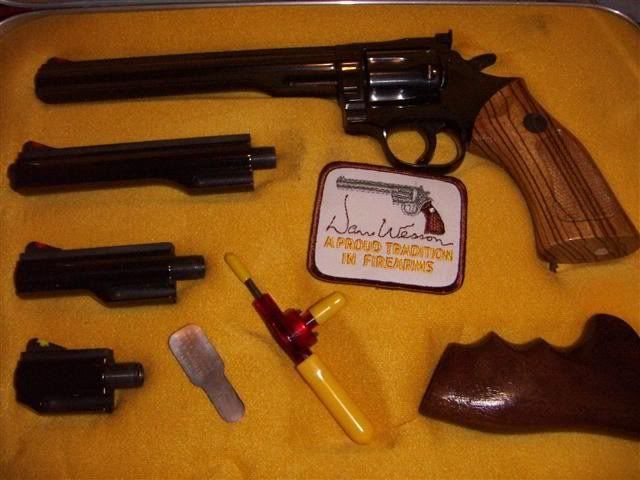Re: Calling a revolver a pistol
The term Pistol, though initially coined to denote the Single Shot Pistols of the day, evolved immediately...as all terms do BTW...to include Multi-Shot Pistols. Multi-lock superimposed Pistols with single and even multiple barrels were produced in the 1500s. Ultimately other multi-shot Pistols including other Wheelock, then Flintlock, Snaphaunce, Percussion and Self Contained Cartridge ignition systems followed. There were not only very early single and double barrel Pistols, but in no time, 3 and 4 barrel Flintlock Duck's-Foot Pistols, 2,3 and 4 barrel Flintlock Tap and Slide Action Pistols. There were Percussion versions of the previous Flintlock Pistols and even Manual Magazine Multi-Shot Pistols. Multi-shot revolving Pepperbox Pistols were the precursor to the original revolver, Colt's Revolving Pistol.
They were all called PISTOLS, including the Revolving Pistol. Pistol is still the correct, proper, technical term when referring to a handgun, regardless of operating system. Have we shortened Revolving Pistol to just revolver in contemporary times? Sure, but before doing so, the US Army was known to drop “Revolver” and just use “.44 Army Pistol” when referring to the Revolving Pistols in use during the War of Northern Aggression. BTW, in the mid-1800s, one who used and was proficient with the Revolving Pistol was in fact called a Pistoleer.
Point of fact, the first order of any size for Sam Colt, to the Republic of Texas Navy in 1839, was for 180 Colt Paterson Revolving Pistols (as well as revolving rifles/carbines). Subsequently, the Colt-Whitneyville Walker, a massive 5+ pound .44 Revolving Pistol was sold as the Walker Pistol. The Colt 1851 Navy Caliber (.36) Revolving Pistol was referred to as the Revolving Holster Pistol to differentiate it from the smaller Pocket Pistols of the time. Colt, the US government, ammunition (paper cartridge) manufacturers and the public alike referred to revolvers as Revolving Pistols.
To forestall the inevitable; “Didn’t happen without pictures”, here are just a couple original period paper cartridge boxes:
For those who rely upon the internet, here is a direct quote from the National Firearms Museum:
"Samuel Colt was born in Hartford, Connecticut on July 19, 1814. He showed an early fascination with science, and during his youth, Colt studied both chemistry and mechanics. While still a boy, he attempted to produce a pistol that was capable of firing multiple shots without reloading, but his efforts were unsuccessful. In 1830-31, while the sixteen year-old Colt was serving as a seaman aboard the brig Corvo, he observed the ship's wheel and the relationship of the various spokes to the center hub. <span style="text-decoration: underline"><span style="font-weight: bold">This inspired him to make a wooden model of a revolving pistol.</span> </span>Although others had already experimented with revolvers, Colt's design was the first to automatically rotate the cylinder when the gun was cocked. After his return to the United States, he showed his model to his father, Christopher, and to Henry L. Ellsworth, a friend of the elder Colt who was then serving as Commissioner at the U.S. Patent Office in Washington. Both men encouraged Samuel to continue with his work and to seek a patent for his design.
At this point in his life, Colt had an idea but no money with which to proceed on his new career path. For the next four years, he worked the traveling show circuit as "Dr. Coult of Calcutta." His lectures and demonstration of nitrous oxide to crowds in the U.S. and Canada provided a source of capital, which was forwarded to gunsmiths who produced working versions of his firearms designs. In addition to the money he received, this period in his life also provided Colt with valuable experience in public speaking, marketing, and public relations. <span style="text-decoration: underline"><span style="font-weight: bold">At age 20, Colt gave up touring and, with borrowed money, traveled to Europe to secure English and French patents for his revolving pistol.</span> </span>Upon his return to the United States in 1836, he also received a U.S. patent.
In March, 1836, Colt formed the Patent Arms Company and began operation in an unused silk mill along the banks of the Passaic River in Paterson, New Jersey. His first product was a ring-lever revolving rifle, available in .34, .36, .38, .40, and .44 caliber, in which a ring located forward of the trigger served to cock the hammer and advance the cylinder for each shot.<span style="text-decoration: underline"> <span style="font-weight: bold">This was soon followed with a revolving pistol. </span></span>These five-shot "Paterson" revolvers featured folding triggers, and were available both with and without loading levers in .28, .31, and .36 caliber. Patent Arms also produced smoothbore revolving carbines and shotguns."
A revolver IS a pistol, the historical record is clear.
Nothing to see here folks, move on

…








